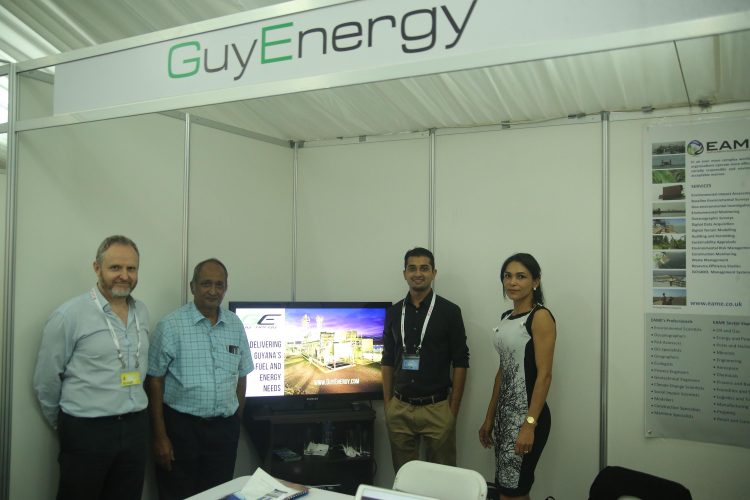Local company GuyEnergy is to build a modular oil refinery in Region 10 at a cost of about two percent of what a paid international consultant to government had said might be needed here.
Expected to be completed “way before” ExxonMobil’s 2020 estimated production start date, GuyEnergy is forging ahead, stating that the venture would cost about US$100m as compared to the US$5B that Pedro Haas, Director of Advisory Services at Hartree , had projected to the government.
Haas was tasked with carrying out a feasibility study for an oil refinery in Guyana and told the David Granger-led APNU+AFC government that the cost to construct such a facility would be some US$5 billion, and would see at least half the invested amount lost upon commissioning.
But Chief Executive Officer of GuyEnergy, Dr. Turhane Doerga, told Stabroek News in an interview yesterday that while there are refineries costing that amount, those are outdated and cater only for large scale refining. He said that he could not rationalise why Haas would advise on a refinery that would require about 120,000 barrels of oil per day, when he has to know there are smaller and more efficient modular types used globally.
“The huge refinery is based on huge storage tanks and you have to run it say at 100,000 barrels a day and you can’t gear down whether you have a market or not. So with those investments, the scale is much bigger and you need much more stuff,” he said.
“The funny thing is that people were talking about building a big refinery because nobody builds big refineries anymore. Nobody. That technology is old,” he added.
Doerga said that his company along with another, EAME of the United Kingdom, invested in a feasibility study of their own and found that it was profitable to have a small refinery here.
“I asked when the presentation [by Haas] was made, ‘Did you consider a modular refinery?’ And the answer was no. I asked, ‘Did you look at how Suriname did it?’ And the answer was no. So I was kind of disappointed. My thing was, why if we paid you so much money, taxpayers’ money, you didn’t look at all the options. You should have looked at all options,” he stressed.
“There are so many of these refineries being used all over the world; already by Chevron, Shell and all the big boys. So for anybody to come and claim that tailoring a refinery to a specific economy is not feasible, it is simply not true because it is happening all over the world, including with the people who are here doing business as well,” Doerga stated.
According to Doerga’s British partner, Steve Rowan, the decision will allow Guyana to make use of the oil industry that is here now because currently as it stands everything is offshore, which means “everything stays offshore. The people of Guyana deserve to get some money out of their oil and they can by bringing that onshore.”
Doerga, who had been a rice miller for many years here, said that the company explained its plan to investors at the just-concluded GIPEX oil conference at the Marriott Hotel this week and already there is a lot of interest.
He said that the company had initially sought investors and was planning to build a small modular refinery in Linden to cater for the energy needs of that town’s alumina plant and to meet the country’s domestic energy requirements. But with all the financial proposals already received at the conference, the company would first review the plan before making a decision.
“For us, it is good to get Guyana going because this will spin off in thousands and thousands of jobs for all kinds of sectors and that is why we are pushing it. After these three days. We no longer have to push, people are pushing us,” Doerga said.
“We are totally upbeat because we have seen so much interest of people to put money into a project. You ask about the feasibility …if you don’t make money with oil you can’t make with anything else. The refinery is modular. It is computer controlled and it will work,” he added.
Added to the attraction to investors, Doerga said, was the fact that the oil which will be pumped offshore is of ‘A’ grade quality.
“We have light sweet crude. In the trade, people call it ruby oil. Luckily for us that is the easier to refine”, Doerga, who has also been pressing for the greenlight for the cultivation of industrial hemp here, said.
Questioned about where they intend to get their crude from for the refinery, Doerga said that since the project will begin before 2020, it will outsource some. But when oil begins to be pumped, it has a commitment from government to buy a portion of the country’s oil.
“Yes, yes the government has given us a letter of no objection,” he stated.
The partners assured that all safety precautions will be in place and that they have catered for protection of the environment.
“I have been in the environmental sector for many years. The key focus for the refinery is environmental protection and safety. This will be a full state-of-the-art abatement systems. All fluids will be within secondary containment systems so there is a pipe break or pipe bust it is not going anywhere it will all be contained. The pipes to the refinery are double skinned. For vessels going out there will be patrols going out with them, there will be patrol vessels, trained oil response teams and the site will be under very stringent environment, management systems as well as quality management systems as well as health and safety management systems. Taking the best examples from around the world. It will be a very clean operational system that runs to a high standard,” Rowan said.
Editor’s note: An earlier version of this story mistakenly gave the refinery figure as US$100,000.
